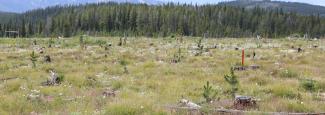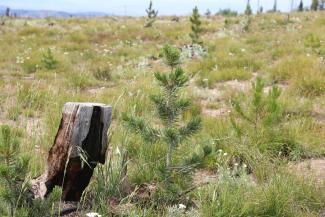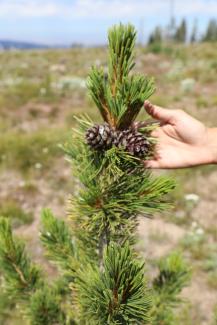Little Bear Whitebark Pine Seed Orchard on the Custer Gallatin National Forest
Charity Parks, Region 1/Custer Gallatin National Forest
September 28th, 2023

Nestled in the rugged mountains of the west exists a is a high elevation ecosystem, renowned as the whitebark pine forest. Typically found above 8,000 feet elevation, the whitebark pine (Pinus albicaulis) holds significant importance as it is considered a key component of the ecosystem across the Greater Yellowstone Area. It serves as an important food source to wildlife, and offers other essential ecological benefits, such as capturing and retaining snow as well as storing carbon. Whitebark pine inhabits the highest elevations where other conifers are often sparse.
Flourishing in the uppermost elevations where other coniferous trees are often scarce, the whitebark pine plays a crucial role.
These forests, along with the communities at treeline, play a pivotal role in stabilizing and shading the snowpack, thus controlling the pace of snowmelt and the subsequent flow downstream. They also contribute to the stabilization of loose, rocky soils and the mitigation of erosion. Remarkably, over 95 percent of the whitebark pine population in the United States is situated on publicly owned lands, encompassing National Forests, Wilderness Areas, and National Parks.
“Whitebark pine are important, their persistence on the landscape effects entire ecosystems. Whitebark pine can occupy elevations where other tree species cannot, they can also move into lower elevations if competition isn’t present. It’s presence on the landscape effects so many different facets of forested ecosystems, everything’s effected by whether it’s present or not.” said Clay Demastus, Silviculture Forester.
The Little Bear Whitebark Pine Seed Orchard is managed by the Custer Gallatin National Forest and it is a cooperative project between the U.S. Forest Service, the NPS and BLM. The orchard will be providing seeds to the National Forests, National Parks, as well as the Bureau of Land Management (BLM) throughout the Greater Yellowstone Area (GYA). It was established in 2013 to produce genetically diverse, disease-resistant seedlings for use in restoration projects across the region. The Little Bear Whitebark Pine Seed Orchard is an important part of the efforts to protect and restore the Whitebark pine. By producing genetically diverse, disease-resistant seedlings, the orchard is helping to ensure that this iconic species continues to play its vital role in the high-mountain ecosystems of the western United States.

Whitebark Pine trees in the Little Bear seed orchard on the Bozeman Ranger District on the Custer Gallatin National Forest.
There are about 350 Whitebark pines growing at the Little Bear Orchard (as of 2023). Photo taken July 31, 2023. View full sized photo on Flickr.
Photo Credit: USDA Forest Service photo by Charity Parks.The future of Whitebark pine has been in doubt over the last several decades with some areas experiencing losses as high as 95 percent. The whitebark pine (Pinus albicaulis) was listed by the U.S. Fish and Wildlife Service as a threatened species in December of 2022, under the Endangered Species Act. There are a number of reasons why they're on the decline that includes changes in the environment, including the climate and fire regimes and then due to some other pathogens including White Pine blister rust which is an introduced pathogen and also mountain pine beetle.
“We were seeing entire mountain sides of red needles where the whitebark are dying. Entire hillsides wiped out by mountain pine beetle and blister rust,” said
Despite facing serious challenges, there is hope for the tree. This orchard is a sign of hope for the tree.
“In the wild it would take a Whitebark pine tree about 30 years to be reproductively mature enough to produce seeds. But in the orchard you'll see small trees in the orchard that are a foot tall and have a big cone on them and that's because they are essentially, the mature parent tree” said Heidi Genito, Seed Orchard Manager. “These are grafts so this material was taken from the tree in the wild and then grafted onto the root stock so it essentially is that parent tree living here at the orchard and so it's already reproductively mature enough to produce cones.”
The seed Orchard is propagating and growing white bark Pine which is a crucial keystone species for the Yellowstone in the greater Yellowstone ecosystem and throughout its entire range.
“From the wildlife side of things, the value is really in the cone and the important seed that it produces and the valuable, large, it's one it produces one of the largest seeds of any tree in this in this ecosystem,” said Josh Hemenway, Custer Gallatin National Forest Wildlife Program Manager.
The seed of a Whitebark pine cone is full of protein, carbohydrates and fats that numerous wildlife species benefit from. Whitebark promotes community biodiversity as both a keystone and foundation species. Its large seeds are an important wildlife food, supporting squirrels, bears, and birds. There's a unique relationship between the White bark pine and grizzly bears, squirrels, and particularly from the perspective of propagation of the seeds, the Clark's Nutcracker. Whitebark pine represents for grizzly bears traditionally a very valuable food source in the fall season as grizzly bears are trying to put on weight in what we call the hyperphagia season right before they go into hibernation.
“White bark Pine seeds have incredible protein and it really represents one of the most perfect food sources for them. It kind of has the nutritious value nutritional value of like butter, essentially, they're able to just eat it and consume and gain massive amounts of calories and they acquire the seeds in kind of an unusual way,” said Josh Hemenway, Custer Gallatin National Forest Wildlife Program Manager.
That's where the squirrels come in. Squirrels climb up in the trees, break open these cones which don't open on themselves, these are sticky large cones where all the seeds are kept, the squirrels haul all the seeds down and they cash them away in middens all around the forest and grizzly bears are really good at finding these middens digging them up and feasting and eating all the squirrel’s food, essentially. That happens through all the fall at the higher elevation range that the grizzly bear or the Whitebark pine exists.
The calorie-rich pine nuts provide an important food source for many bird and small mammal species. The cones harvested and stored by pine squirrels are raided by grizzly bears and this is a key food source for grizzly bears during the autumn months as they prepare for hibernation.
Grizzly bears are generalists, they're omnivores, they eat just about everything you can possibly imagine and while white bark pine represents an important source for many of the grizzly bears it's not all that the bear consumes. The grizzly bears obviously take advantage of this potential food source and with the decline in Whitebark pine, it has resulted in grizzly bears needing to seek alternate food sources in the ecosystem which may result in shifts and ranges of distributions as they're looking for different things to eat.
An interesting relationship exists between a loud, handsome non-migratory bird, the Clark’s nutcracker, and whitebark pine, and it’s an interesting and unique feature in the greater Yellowstone ecosystem. Whitebark pine cones don’t open naturally, as do most other pine cones. Rather, the cones are ripped apart by Clark’s nutcrackers, which feed on some of the fresh seeds and then cache the rest to eat later. So, in order for distribution of the cones and propagation of the cones it's completely reliant on this species of bird. Whitebark pine reforestation occurs when these buried seeds germinate. Clark's Nutcracker is a j-sized bird species 10 to 11 inches in size and a light gray in color with some black on its wings and it has this very pointed lance-like specialist specialized bill that allows it to break open the cone and access the seeds and it's able to store in a pouch up under its tongue, 100-150 seeds at once and then it proceeds to fly all over the area all over the ecosystem and all sorts of different habitats and it caches or stores these seeds four or five little chunks of at a time and berries them. A single Nutcracker can have thousands if not tens of thousands of caches all around the ecosystem and what's remarkable is the Nutcracker remembers where most of these things are but it doesn't get all of them and the ones that it doesn't get, well that's the source for potential new Whitebark pine seedlings in the future.
“It’s absolutely essential, this relationship with the Clark’s Nutcraker, in order for Whitebark pine to be propagated and keep spread throughout the ecosystem and germinate into our future Generations,“ said Josh Hemenway, Custer Gallatin National Forest Wildlife Program Manager.

A Whitebark Pine tree in the Little Bear seed orchard on the Bozeman Ranger District on the Custer Gallatin National Forest. This tree is just one of the 350 whitebark pines growing at the Little Bear Orchard. Photo taken July 31, 2023. View full-sized photo on Flickr.
Photo Credit: USDA Forest Service photo by Charity Parks.Prep work for establishment of the seed orchard was started in 2011 on 7 acres of land at 8,800 ft elevation. The first grafts were planted in 2013.
The orchard started with grafts that were representatives from 30 different trees in the wild found to have superior genetics. These trees are ranked according to their rust resistance, cold heartiness, and drought tolerance.
The primary step in the restoration of whitebark pine revolves around securing the species future populations with a degree of resilience against blister rust by increasing the prevalence of trees possessing genetic resistance to the blister rust pathogen.
White pine blister rust is an exotic fungal disease that came to western North America around 1910. Since then, it has spread throughout the range of most five-needle pines in the United States and Canada. It effects all whitepines and Whitebark pines being one of those.
A fundamental goal of the seed orchard operation is to monitor blister rust performance and other key adaptive traits to ensure seedlings from the orchard are well-equipped to survive and thrive in the various conditions it faces from weather conditions to interactions with animals. In collaboration with the assistance of Forest Service regional geneticists, cones were collected from trees throughout the Greater Yellowstone Area (GYA) that exhibited signs of resistance to blister rust, an exotic pathogen causing significant mortality among 5-needled pines throughout the area. Seeds extracted from these cones were grown in a nursery and then tested using spores of blister rust. The highest-ranking 30 trees were then grafted onto potted rootstock. Replicates of these genetically superior trees, which were planted in 2013, have matured and are now producing rust resistant seeds for restoration and reforestation efforts. Beginning with 52 trees, this orchard has since expanded to include around 305 trees as of 2023.
A pivotal aspect of any whitebark pine restoration program revolves around the planting of seeds or seedlings with rust-resistant qualities, aiding for reforestation efforts. Conservationists collect cones from healthy trees and using the seeds from those cones to help restore the ecosystem. And using seeds from the cones to grow hundreds of thousands of disease resistant seedlings that can be planted back on the landscape.

Heidi Genito, Seed Orchard Manager touching the cones of a Whitebark Pine tree in the Little Bear seed orchard on the Bozeman Ranger District on the Custer Gallatin National Forest. Photo taken July 31, 2023. View full-sized photo on Flickr.
Photo Credit: USDA Forest Service photo by Charity Parks.A Whitebark Pine tree in the Little Bear seed orchard on the Bozeman Ranger District on the Custer Gallatin National Forest. This tree is just one of the 350 whitebark pines growing at the Little Bear Orchard. USDA Forest Service photo. View full-sized photo on Flickr
“The work at the seed orchard is important because we are growing up rust resistant grafts that will produce rust resitent seeds and putting those back out on the landscape is really important so it can give it a fighting chance against the rust.” said Clay Demastus, Silviculture Forester.
“This is a significant accomplishment for Whitebark pine restoration in the Greater Yellowstone! The seed orchard has grown to 305 trees and are hoping to grow our orchard to 480 within the next 5 years” said, Heidi Genito, Seed Orchard Manager.
As the Little Bear Orchard matures and produces larger cone crops it will become the main source of Whitebark Pine seeds for the Greater Yellowstone Ecosystem that are rust resistant.
Through the establishment of seed orchards like the Little Bear seed orchard and the cultivation of high-quality seedlings, scientists are working to ensure a future for the Whitebark pine and the valuable ecological services it provides.
“Thanks to the efforts of dedicated scientists, foresters, and conservationists, the Little Bear Whitebark Pine Seed Orchard is helping to ensure a future for the Whitebark Pine, and the many species that depend on it, for generations to come,” said Julee Shamhart, Executive Director, Whitebark Pine Ecosystem Foundation.
The Little Bear Whitebark Pine Seed Orchard is an important part of the efforts to protect and restore the Whitebark pine. By producing genetically diverse, disease-resistant seedlings, and with every cone collected and seedling planted, people are helping to ensure that this iconic species continues to play its vital role in the high-mountain ecosystems of the western United States.
References:
A Range-Wide Restoration Strategy for Whitebark Pine (Pinus albicaulis)


